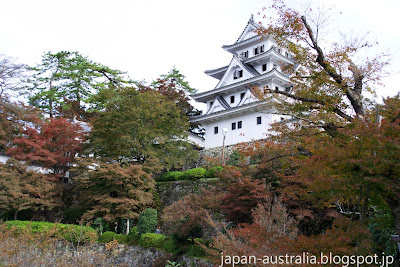Christmas food in Japan includes traditional KFC Christmas Chicken Dinner. Kentucky Fried Chicken has become synonymous with Christmas in Japan since they launched their advertising campaign in the 1970s. You will usually see the Colonel dressed up in Santa gear around this time. There are long lines at KFC on Christmas Day and many people pre-order their Christmas feast well in advance to avoid missing out. It is estimated that 1 in 3 Japanese adults will eat fried chicken this Christmas!
KFC Japan Website
 |
| The Colonel dressed as Santa Claus for Christmas |
The retail stores and shopping malls scattered all around Japan have been the most enthusiastic about Christmas, with large Christmas trees, Santa Clauses and seasonal decorations out in force several weeks or months in advance. This year the decorations came out the day after Halloween!
 |
| Christmas decorations in Japan |
 |
| Christmas Tree in Shopping Mall |
Christmas was first celebrated in Japan during the Sengoku Period, also known as the Warring States Period, in the 16th Century. It was during this time that a missionary, Francis Xavier introduced Christianity to Japan. The modern celebration of Christmas in Japan first started around 1900 during the Meiji Restoration when Japan opened up to the West after a long period of isolation. Japanese Christmas Cake first hit the streets in the 1920s at department stores in Ginza, Tokyo. As mention above, KFC started their Christmas Fried Chicken marketing campaign in the 1970s and the rest is history.
Over the last few years, more and more people are starting to celebrate Christmas like we do in the west. They are taking up traditions such as decorating their home, exchanging gifts and having a nice Christmas dinner. The Winter Illuminations have become a big deal during this time with magical displays put on by several places. They are popular with couples out on a romantic date as well as families.
 |
| Winter Illuminations at Nabana no Sato |
How to spend a Festive Christmas in Japan like back home
There are several places in Gifu/Nagoya, my home in Japan that have the goodies you need to make a Festive Christmas just like at home.
Kaldi Coffee Farm located in most of the big malls in Gifu such as Morela, Masa21, Aeon Mall Kakamigahara and Aeon Mall Kisogawa. They have a lot of different imported food such as chocolate, candy, shortbread and snacks for those Christmas stockings.
Plant6 in Ogaki has a range of cheeses, party foods, snacks, cookies and meats.
Amika in Akenabe-cho and Masaki in Gifu has a large range of frozen meats including whole chickens.
FrancFranc in Morela, Gifu & Nagoya Parco has lots of different Christmas decorations as well as Tokyu Hands in Takashimiya Nagoya.
Loft in Gifu City and Sakae Nagoya also has lots of Christmas decorations, Christmas trees & lights and stationary like Christmas cards.
Meidi-ya in Sakae, Nagoya specialises in foreign food and has a range of Christmas goodies.
Seijyo-ishi in Meieki, Nagoya is a foreign food supermarket with a good selection of foreign food.
 |
| Kaldi Coffee Farm |
Krispy Kreme Doughnuts Japan have also released a range of Christmas themed doughnuts to light up the festive season. They include Snowman Chocolate, Pistachio Wreath and Stollen Ring. You can pick up a Santa Claus Dozen that features the above doughnuts as well as a special Santa Cheesecake Doughnut for 2000 yen.
Krispy Kreme Doughnuts Japan
 |
| Krispy Kreme Santa Claus Dozen |
Wherever you are in the World, the team here at Japan Australia would like to wish you a Merry Christmas!





















































